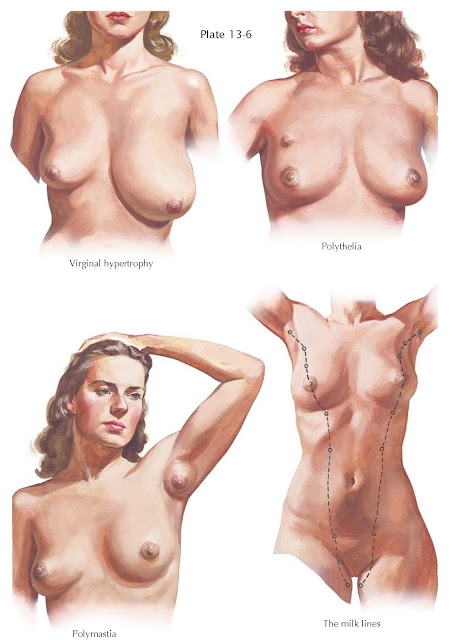POLYTHELIA,
POLYMASTIA, HYPERTROPHY
Congenital anomalies of the breast, such as agenesis or amastia, aplasia, or the absence of nipple and/or areola, are extremely rare. (Athelia or amastia is sometimes associated with Poland syndrome, consisting of absent chest wall muscles, absence of ribs 2 to 5, and deformi- ties of hands or vertebrae.) An increase in the number of mammae or of nipples only is encountered somewhat more frequently. Both these conditions find ready explanation in the embryologic development of the breast. During the 6th to the 12th week of fetal life, the mammary glands first develop as solid down growths of the epidermis that extend into the mesenchyme from the axilla to the inguinal regions the milk lines. Later, these ridges disappear, except in the pectoral area where the normal breast develops.
Accessory or supernumerary nipples
(polythelia) occur in about 1% of men and 2% of women. These cases are
sporadic; although familial polythelia is recognized, it is extremely rare.
Most supernumerary nipples resemble a mole or birthmark and are only
recognizable because of their anatomic location. Most often the supernumerary
nipples are found 5 or 6 cm below the normal pair and toward the midline. They
are usually not associated with significant amounts of underlying mammary
tissue. The accessory nipples without accessory mammary tissue are found
anywhere in the course of the milk lines of the embryo. In the adult, this
extends from the axillary to the inguinal regions. In the regions below the
breast, the milk line runs medially to the normal nipple; above the breast it
runs laterally toward each axilla. Supernumerary mammary glands (polymastia)
situated laterally are more apt to be of considerable size and to undergo
normal lactation compared with those situated medially. Bilateral axillary
breasts that are of small size may develop during pregnancy and undergo
lactation. They occur in approximately 1% to 2% of women of European descent
and 5% to 6% of Asian women. Accessory breast tissue has been classified into
eight levels of completeness from a simple patch of hair to a milk-bearing
breast in miniature. This classification is based on the presence of glandular
and fat tissue, a nipple, an areola, or tufts of hair.
Aberrant mammary tissue in the
axilla without nipple formation is more prone to malignant change than is a
supernumerary breast, in which the frequency of tumor occurrence is seemingly
the same as with a normal single breast. Either benign or malignant tumors can
occur in supernumerary or aberrant tissue. A 2000 American Journal of
Cardiology article postulated a possible relationship with mitral valve
prolapse.
Mammary hypertrophy is a common
anomaly of the breast and affects both sexes. In females, the major forms of
mammary hypertrophy are precocious or infantile hypertrophy and virginal or
gravid hypertrophy occurring, respectively, in
adolescent or pregnant women. Precocious mammary hypertrophy is associated with
endocrine disturbances of the ovary. It is bilaterally symmetric and rarely of
a marked degree. Virginal and gravid hypertrophies are of unknown origin and
may be bilateral or unilateral, and the affected breast may grow to enormous
size. The enlarging organs are composed of increased amounts of fibrous stroma
with hypertrophied ducts, associated at times with lobular formation. The
enlargement, once formed, persists.
When this type of hypertrophy occurs
in teenage girls, it can have a deeply disturbing effect on a teenager’s
self-image and social development. The only effective treatment is reductive
mammoplasty.
Some degree of asymmetry of breast
development is common, with roughly 3% of patient examinations notable for
asymmetric volume differences relative to the contralateral breast. This
asymmetry represented a benign, normal variation unless an associated palpable abnormality is present.





